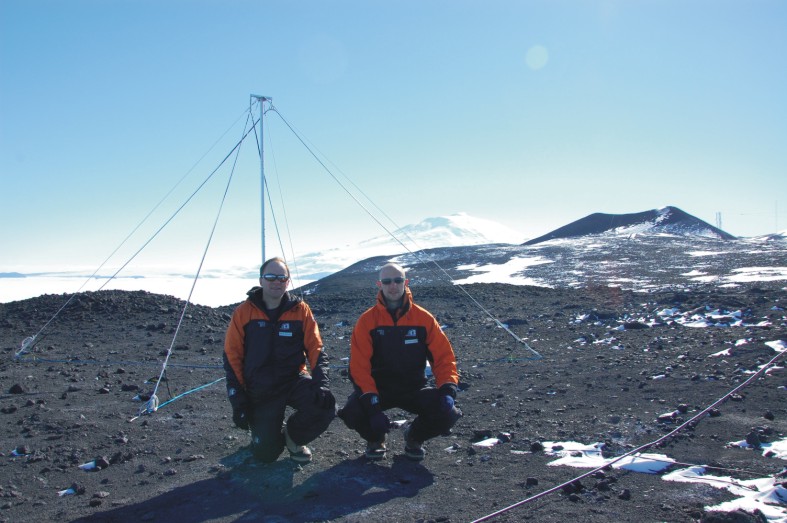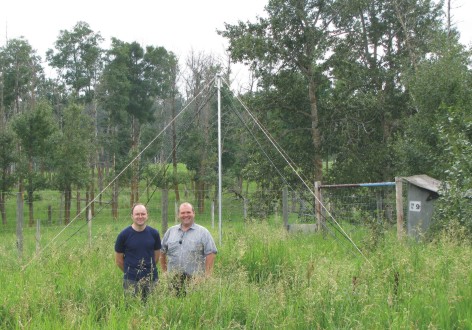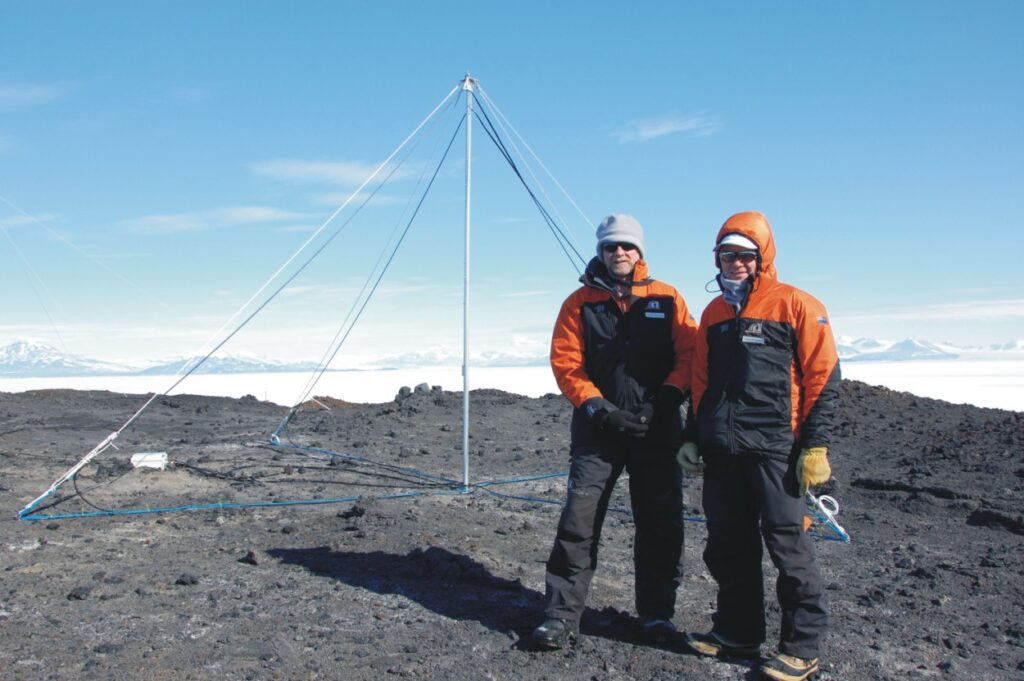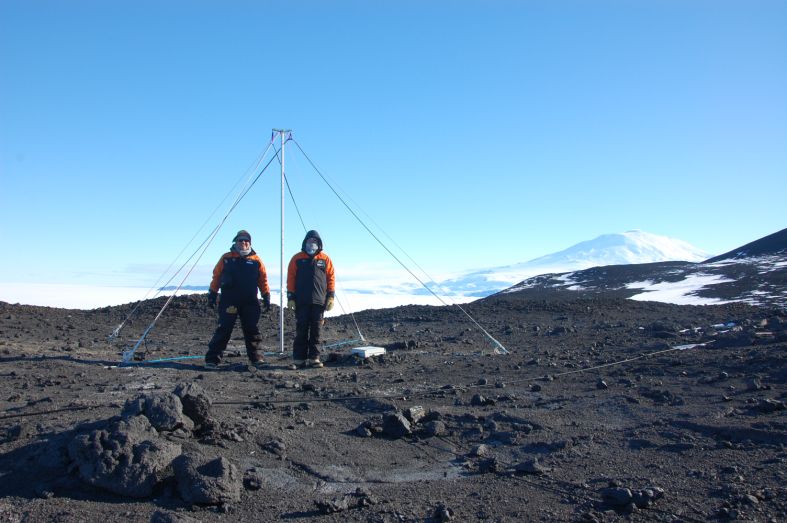Space Physics Research Students to Graduate Tomorrow
Congratulations to Space Physics graduate research students Bonar Carson and Kathy Cresswell-Moorcock who will be graduating at the University of Otago ceremony tomorrow. Bonar will pass across to the stage to have his MSc conferred, while Kathy is graduating with a PGDipSci. Both have been awarded their qualifications with Distinction. Well done to Bonar and Kathy! [14 December 2012].
Otago Space Physics Antarctic Expedition 5 Now Home
The two-man team making up the fifth Antarctic expedition from the Otago Space Physics group to Antarctica returned to Dunedin on Tuesday this week. Dr James Brundell, the event leader, and Dr Ian Whittaker, flew out of Antarctica on the morning of Monday 3 December on a USAF C-130, and landing in Christchurch in the early evening. During thier time in Antarctica they moved our computer and electronics into a new room in the Arrival Heights Kiwi Lab, gathered data, checked the gear was well, and undertook electromagnetic noise measurements. All the data from our AARDDVARK experiment looks good, before and after the shift. Another successful (and quick) trip to Antarctica. The logistics support for Expedition 5 is provided through Antarctica New Zealand Event K060. [7 December 2012].

James and Ian next to the AARDDVARK antenna with Erebus in the background.
Update from Otago Space Physics Antarctic Expedition 5
The two-man team making up the fifth Antarctic expedition from the Otago Space Physics group to Antarctica travelled to Christchurch on Sunday to be issued their Antarctic clothing. On Monday morning Dr James Brundell, the event leader, sent us a SMS alerting us they were delayed about 1 hour, but by 706am that morning he SMSed “On plane!” and by Monday afternoon James and Dr Ian Whittaker were emailing us back in Dunedin to confirm they had arrived at Scott Base. After a base tour they are scheduled to have dinner, their bags arriving at 7pm, and Antarctic Field Skills training starting at 845am Tuesday morning. The logistics support for Expedition 5 is provided through Antarctica New Zealand Event K060. [26 November 2012].
Expedition 5 prepares to depart for Antarctica
The fifth Antarctic expedition from the Otago Space Physics group is preparing for their trip South. Dr James Brundell, the event leader, is currently working alongside Dr Ian Whittaker, to undertaken noise tests and become familiar with some of the experimental equipment they will use when south. The team is scheduled to travel to Scott Base on Monday 26 November 2012 for a eight-day intensive working period. The logistics support, comprising air transport, accommodation, and all other on-ice support is provided through Antarctica New Zealand Event K060.
James and Ian are heading to Scott Base to work on Otago’s AARDDVARK radio receiver which is located at Arrival Heights, not far from Scott Base. James was one of the two man Space Physics team who deployed this radio receiver in December 2008. The main aim for Expedition 5 is to move our experiment from one room of the New Zealand lab at Arrival Heights into a neighbouring room. In late 2010 a powerful LIDAR experiment was installed by US researchers in the room our experiment was located. The new LIDAR experiment has led to some issues for our experiment, which we hope to mitigate by moving next door. Ian and James will also undertake measurements of the VLF noise in and around the Arrival Heights area. Interested? You can read more at this webpage [13 November 2012]
More repairs made to Alberta AARDDVARK receiver
In early August 2012, the signal at the Ministik Lake AARDDVARK antenna suddenly dropped out – less than 3 weeks after we had travelled to Canada to repair it. We quickly identified the problem had been caused by a near-by lightning strike, which must have damaged the experiments electronics. Today, 9 November 2012 (NZ time) staff from the Space Physics Group from the University of Alberta went out to Ministik Lake and replaced the preamp – and the data is now flowing again. The new preamp has been upgraded to withstand lightning better in the future. We hope. This instrument has certainly had a very hard time, detailed on this webpage. [9 November 2012].
Craig and Aaron in Brazil
In early September 2012 Assoc. Prof. Craig Rodger and Space Physics PhD student Aaron Hendry travelled to Sao Paulo (Brazil) to attend the 5th VERSIM workshop, the first time the workshop had been held outside of Europe. Because of the transport links between New Zealand and Brazil they flew via the United States, which allowed us to visit the Udvar Hazy Center (Smithsonian Air and Space Museum). There is a particularly nice image on the space physics image collection of Aaron Hendry standing in front of the Space Shuttle Discovery (OV-103). During the VERSIM workshop one of Craig’s presentations was recorded and put up on You Tube. People often comment on Craig’s presentation style, and this is an example of him in action [6 September 2012].
Repairs made to Alberta AARDDVARK receiver
In mid-July 2012 Dr James Brundell and Assoc. Prof. Craig J. Rodger travelled to Edmonton in Canada to repair AARDDVARK antenna installed at Ministik Lake, Alberta, Canada. The antenna was installed in October 2010, and is located at a field site of the Space Physics Group from the University of Alberta. The Ministik AARDDVARK antenna also provides data to the world wide lightning location network, WWLLN. This instrument has had a hard time, detailed on this webpage. It has suffered from computer failure and the attention of the local wildlife. Craig and James headed out to repair and upgrade the instrument, so it is better suited to make continuous measurements in the next few years to support the RBSP and DSX spacecraft missions, and the BARREL balloon campaigns [21 July 2012].

James and Craig with the repaired antenna.
Postdoc Dr Ian Whittaker arrives from the UK
Dr Ian Whittaker arrived in the Space Physics group in early July 2012, taking up a Postdoctoral Fellowship position – Ian is working on energetic electron precipitation and its link to the plasmasphere, funded by the European Union FP7 project (PLASMON). W are thrilled to welcome Ian to the group, and hope to add his photo to the group website soon. [5 July 2012].
Update from Bonar Carson
Former Space Physics MSc student Bonar Carson is now living in Auckland working as a financial analysis for ASB. We have received a picture of Bonar showing him in his new work environment and looking sharp indeed. The examination process for Bonar is all over bar the corrections, and we have recently submitted a paper to the Journal of Geophysical Research based on his MSc work. Bonar is now about to feature in the Otago Physics Department publicity material, in the Graduate Profile section [12 June 2012].
Mark Clilverd visiting us from the British Antarctic Survey
Our long term collaborator, British Antarctic Survey scientist Dr Mark Clilverd, has arrived in Dunedin to work with us. Mark will be in Dunedin for the next two weeks or so, are focusing on radiation belt and substorm-driven precipitation studies. Our main goals for Mark’s visit is to finish off some research papers and to get Mark working with some of our new research students [18 April 2012].
Craig interviewed on National Radio, Twice
Space Physics academic Assoc Prof. Craig Rodger was interviewed on the Morning Report show on New Zealand’s National Radio. The interview concerned the X5 solar flare which occurred on 7 March 2012, and the impact of the associated coronal mass ejection. The interview is online on their website [9 March 2012]. The next day Craig was interviewed on Saturday morning with Kim Hill, and this interview is also online [10 March 2012].
Mea interviewed on Radio One
Space Physics PhD student, Dr Mea Simon Wedlund, was interviewed by Radio One 91 FM. This will be broadcast on Wednesday 21 January 2012 from 10am and streamed online. Afterwards it will be available online as well (Mea’s interview starts at about 1 hour 15 into the show)! [21 February 2012]
Bonar submits his MSc thesis, heads off to work
Space Physics MSc student, Bonar Carson, submitted his thesis Satellite Observations of EMIC wave driven REP at the end of January. He then headed off to Auckland where he is about to start up a new job with ASB Bank. Well done Bonar! [31 January 2012]
Public Talk at SANSA, South Africa
Last month Assoc. Prof. Craig Rodger gave a public talk at the Space Science Directorate of the South African National Space Agency (SANSA) in Hermanus, South Africa. The talk was entitled And then the Sun went “BANG” and was delivered to a “standing room only” lecture room on the SANSA Space Science site. Craig was visiting Hermanus for a business meeting of the EU FP7 PLASMON project the week beforehand, and the locals took advantage of the chance to include a Public Talk in his time there. The talk was featured in the local newspaper, the Hermanus Times, and Craig also gave a 45min live radio interview to Whale Coast FM. [30 January 2012]
Space Physics PostDoc Position Available (Note this is now filled)
The Otago Space Physics group is currently advertising for a Postdoctoral Fellowship position. This is funded through our EU FP7 project (PLASMON) and is a 2-year fixed term position. The project aims to investigate the loss of energetic electrons from the Van Allan radiation belts into the atmosphere and the link to plasmaspheric properties. The position is available from this date, and will remain open until it is filled (the candidate must start at Otago by the middle of 2012). Applicants should have a PhD in Physics and a demonstrated strength in one of the areas of Space Physics, Ionospheric, Upper Atmospheric and/or Geophysics. For further information, please see the Job Description. [26 January 2012]
Space Physics Graduation Celebrations
On 17 December 2011 the Space Physics group celebrated the graduation of two of our research students. Former PhD student Dr Rory Gamble and BSc(Hons) student Aaron Hendry walked across the stage of the Regent Theatre, and were formally capped by the Chancellor of Otago University. Congratulations to both the new graduates! [20 December 2011]
Expedition 4 returns
The fourth Antarctic expedition from the Otago Space Physics group returned from the ice last Monday (5 December 2011) after a successful visit. After some weather-related delays, the two man team set off on Monday 28 November 2011, and with hard work managed to complete the primary goals of the expedition in time to fly back only 1 week later.
Dr James Brundell, the event leader, and Mr Peter McCabe, Physics Department Head Technician, replaced a faulty cable for our AARDDVARK radio receiver which is located at Arrival Heights, not far from Scott Base. James designed the original equipment which we installed in December 2008, and has now visited the experiment three times (so far). During their time on the ice they also collected data and undertook measurements of the VLF noise in and around the Arrival Heights area. [8 December 2011]

Peter McCabe and James with the antenna.
Expedition 4 prepares to depart for Antarctica
The fourth Antarctic expedition from the Otago Space Physics group is preparing for their trip South. Dr James Brundell, the event leader, is currently working alongside Mr Peter McCabe, Physics Department Head Technician, to test the experimental equipment they will use on the ice. The team is scheduled to travel to Scott Base on Wednesday 23 November 2011 for a ten-day intensive working period. The logistics support, comprising air transport, accommodation, and all other on-ice support is provided through Antarctica New Zealand Event K060.
James and Peter are heading to Scott Base to work on Otago’s AARDDVARK radio receiver which is located at Arrival Heights, not far from Scott Base. James was one of the two man Space Physics team who deployed this radio receiver in December 2008. In the last months the receiver has developed some problems – data is still being collected, but its clear that repairs and maintenance are in order. In addition, Peter and James will undertake measurements of the VLF noise in and around the Arrival Heights area. You can read more at this webpage which describes the trip. [10 November 2011]
Dr Rory Gambles completes PhD, is awarded “Exceptional Thesis”
In late March 2011 Rory Gamble submitted his PhD thesis (“The 17-19 January 2005 Atmospheric Electron Precipitation Event”); last week we had confirmation that his thesis had been accepted following the examination process and that his work is to be placed on the list of Science Division Exceptional PhD Theses. According to the University of Otago Science Division website: “A thesis is of exceptional quality when all three examiners of a candidate’s thesis agree that the thesis is of an exceptional standard in every respect – research content, originality, quality of expression and accuracy of presentation – and is amongst the top 10% of theses examined.” Congratulations Rory! [3 October 2011]
Dr Mea Simon Wedlund has arrived to join the group
Dr Mea Simon Wedlund has joined the group to start a PhD with us. Mea has travelled from Europe, having recently completed her first PhD at the Université Pierre et Marie Curie in Paris. She will now undertake a second PhD with the Otago Space Physics group. Her PhD research will focus on AARDDVARK-measured particle precipitation, and is funded by the New Zealand Marsden fund. [22 September 2011]
AARDDVARK covered on New Zealand’s World Space Week website
A story on our AARDDVARK network has been published on the New Zealand website for World Space Week (4-10 October in 211). In the story Assoc Prof. Craig Rodger (University of Otago) explains how New Zealand scientists and a global team are helping monitor space explosions and ozone depletion. Read the Radio AARDDVARK webpage, part of the NZ Space Showcase. [14 September 2011]
Craig Rodger wins Otago Teaching Excellence Award
On 20 June 2011 it was announced that Associate Professor Craig J. Rodger from the Space Physics group was one of three Otago academics who have received the 2011 University of Otago Teaching Excellence Awards. The three winners were: Dr James Maclaurin (Philosophy), Associate Prof Craig Rodger (Physics), and Mr Tony Zaharic (Biochemistry). Head of the Department of Physics Professor Rob Ballagh commented, “There is no risk of being bored in one of Craig’s lectures. You can be sure it will be lively and energetic, and Craig’s enthusiasm rubs off on the students. Craig brings a total commitment to every aspect of his teaching, including lecturing, organisation, and marking. The students greatly appreciate this. We are very lucky to have Craig. He is a great teacher.” More details are available from the University Media Release. [20 June 2011]
Rory Gamble submits PhD, wins Prize!
In late March 2011, PhD candidate and Space Physics student Rory Gamble submitted his PhD thesis (“The 17-19 January 2005 Atmospheric Electron Precipitation Event”); the next day he left New Zealand to take up a research position at the Sodankylä Geophysical Observatory in Finland. Almost at the same time we found out that Rory had won a Outstanding Student Paper Award in Space Physics & Aeronomy for his presentation at the American Geophysical Union 2010 Fall Meeting in San Francisco, California. Congratulations to Rory on a very impressive week! [31 March 2011].
Space Physics group receives funding from the European Union
Exciting news from Europe – in collaboration with our European, US and South African colleagues, we are being funded through a European Union FP7 project. The project is entitled “A new, ground based data-assimilative modeling of the Earth’s plasmasphere – a critical contribution to Radiation Belt modeling for Space Weather purposes“, and has the short name PLASMON. It includes multiple institutions worldwide but is led by Dr. Janos Lichtenberger of Eötvös University (ELTE), Budapest – Hungary, who has visited us twice before in Dunedin. We will be strongly involved in Work Package 4, which will make use of AARDDVARK data, and Assoc. Prof. Rodger is the leader of Work Package 5, dissemination. The Otago support is €352,357 (out of €1,972,269 total), and will fund a PostDoc and a PhD student in the Otago Space Physics group. More information at the PLASMON website. [12 January 2011].
Space Physics Hosts Ratu Sir Kamisese Mara Fellow
From January-April 2011 the Otago Space Physics group is hosting Assoc. Prof. Sushil Kumar of the University of the South Pacific (Fiji). Assoc. Prof. Kumar is visiting the as the 2011 Ratu Sir Kamisese Mara Fellow, an award which funds staff from the University of the South Pacific to work for up to 3 months with researchers from Otago. Assoc. Prof. Kumar plans to work with us on lightning, red sprites, and subionospheric VLF propagation. [10 January 2011].
In the footsteps of Scott
In November 2010 an international two-man team will be travelling to Antarctica to visit the Otago Space Physics Group’s experiment. The team is scheduled to travel to Scott Base on Wednesday 24 November 2010 for a brief seven-day visit to the ice. Dr Craig Rodger, the event leader, will accompany British Antarctic Survey scientist Dr Mark Clilverd. The logistics support, comprising air transport, accommodation, and all other on-ice support is provided through Antarctica New Zealand Event K060.
The researchers are travelling to Antarctica to undertake maintenance on Otago’s AARDDVARK radio receiver which is located at Arrival Heights, not far from Scott Base. The Space Physics group deployed this radio receiver in December 2008. Feedback from the Antarctica New Zealand Scott Base technicians have identified damage to our antenna cables, likely caused by the strong winds at Arrival Heights. Mark and Craig will be replacing these cables, checking for other damage, gathering up the data for the last year, and undertaking calibration of the gear.
You can read more at this webpage which describes the trip. [22 November 2010]
New AARDDVARK site added to network
Dr Craig Rodger travelled to Alberta, Canada, to add a new AARDDVARK antenna to the network of VLF receivers. The antenna was installed at Lake Ministik, a CARISMA field site of the Space Physics Group, University of Alberta. Dr Craig Rodger and Dr Mark Clilverd (British Antarctic Survey) installed the new receiving equipment during a week in mid-October. The antenna will feed measurements to the AARDDVARK and WWLLN networks. [17 October 2010]
Space Physics wins Marsden support
The Space Physics research group has been awarded a $700,000 project grant from the New Zealand Marsden Fund. This grant will support the research of Otago Staff Dr. Craig Rodger and Assoc. Prof. Neil Thomson plus Dr. Adian McDonald of the University of Canterbury for 3-years starting March 2011. You can read more about our proposed research from this webpage. [24 September 2010]
Craig Rodger gives Plenary Lecture at SAIP
Dr Craig Rodger travelled to South Africa to give a Plenary Lecture at the 55th Annual Conference of the South African Institute of Physics, which was held in Pretoria, South Africa. While in South Africa was hosted by the Hermanus Magnetic Observatory, and also gave seminars at the University of Cape Town and the University of KwaZulu-Natal. [7 October 2010]
Rob completes his MSc
Space Physics MSc student Rob McCormick has now been formally advised of his mark, having completed her project. Rob was working on an improved fullwave computation model to describe subionospheric VLF propagation. Well done Rob! He has now moved on to working for the Otago DHB. [21 September 2010]
Mark leaves after his 2010 visit
Dr. Mark Clilverd, visiting the group from the British Antarctic Survey has now headed out of Dunedin, on his way back home. Mark spent 2.5 weeks with us, primarily working with Dr. Craig Rodger, but also Assoc Prof. Neil Thomson, and students Rory Gamble and Sarah Dietrich. Mark is a regular visitor to Dunedin, and some of the visit was used so he and Craig could plan their joint activities in 2010. We hope to see him again for Summer next year. We enjoyed some walks around Dunedin, some dinners out, and of course a lot of Scientific Discussion. [24 January 2010].
Sarah completes her MSc
Space Physics MSc student Sarah Dietrich has now been formally advised of her mark, having completed her project. Sarah was comparing relativistic electron microburst observations from our ground-based AARDDVARK data with satellite measurements. She plans to graduate in May 2010. Well done Sarah! She is currently working inside the group as part of a Summer Bursary. [22 January 2010]
Intrepid Journey – part 2
Dr James Brundell and Space Physics PhD student Mr Rory Gamble returned from Antarctica on 12 December 2009. Their entire journey went to plan, with all the goals of the expedition met. Event K060 is looking good for the next year of data gathering from Scott Base! [22 December 2009]

Intrepid Journey
The Space Physics Group of the Physics Department is about to send two researchers to Antarctica. The two-man team is scheduled to travel to Scott Base on Wednesday 2 December 2009 for a brief nine-day visit to the ice. Dr James Brundell, the event leader, will accompany Space Physics PhD student Mr Rory Gamble. The team’s transport and on-ice support will be provided through Antarctica New Zealand Event K060.
The researchers are travelling to Antarctica to gather data from Otago’s AARDDVARK radio receiver which is located at Arrival Heights, not far from Scott Base. The Space Physics group deployed this radio receiver in December 2008, and a big part of this year’s trip is to see how the antenna and electronics have survived a year in the very high winds and cold temperatures up at the Heights.
You can read more at this webpage which describes the trip. [23 November 2009]
Scientists find solar footprints in the snow
A new study by the Space Physics group and their collaborators shows that the magnetic space storms that create the northern and southern lights could lead to a better understanding of natural temperature variations in the polar regions. Surprisingly, large temperature changes may be linked to auroral activity. More information is available from this webpage. [4 November 2009]
For newer or older news, look at the drop down Space Physics News Listing!